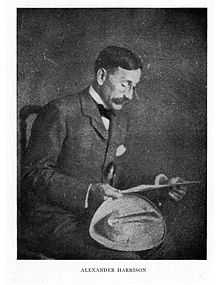T. Alexander Harrison

Thomas Alexander Harrison (January 17, 1853 in Philadelphia, Pennsylvania – October 13, 1930 in Paris, France), was an American marine painter who spent most of his career in France.
Career
He studied at the Pennsylvania Academy of Fine Arts in Philadelphia, 1871-72. For nearly six year he worked as a draftsman for a United States government survey expedition mapping the Pacific coast. He studied for a short time at the San Francisco School of Design. In 1879, he moved to Paris and studied at the École nationale supérieure des Beaux-Arts under Jean-Léon Gérôme and Jules Bastien-Lepage.[1]
Chafing under the restraints of the schools, he traveled to Brittany, where at Pont-Aven and Concarneau he turned his attention to marine painting and landscape.
A figure-piece he sent to the 1882 Salon attracted attention, a boy daydreaming on the beach, which he called Châteaux en Espagne (Castles in Spain) (1882, Metropolitan Museum of Art).[2] In the 1885 Salon, he had a large canvas of several nude women called En Arcadie (1885, Musée d'Orsay),[3] a remarkable study of flesh tones in light and shade which had a strong influence on the younger men of the day. This received an honourable mention, the first of many awards conferred upon him. Les Amateurs (1882-83, Brauer Museum of Art), was awarded a first medal at the 1889 Paris Exhibition. Other honors included the 1887 Temple Gold Medal of the Pennsylvania Academy of Fine Arts, and medals in Munich, Brussels, Ghent, Vienna and elsewhere.
He was decorated by the Legion of Honour, and was an officier of Public Instruction, Paris. He was a member of the Société Nationale des Beaux-Arts, Paris; of the Royal Institute of Painters in Oil Colours, London; of the Secession societies of Munich, Vienna and Berlin; of the National Academy of Design, the Society of American Artists, New York, and other art bodies.
His reputation rests on marine pictures such as The Wave (1885, Pennsylvania Academy of the Fine Arts),[4] with long waves rolling in on the beach, and great stretches of open sea under poetic conditions of light and colour.
Marcel Proust
Harrison rented a ramshackle cottage near the Brittany town of Beg-Meil, and each evening raced to the dunes to watch the sun set over the ocean. In late-summer 1896, he was joined there by struggling writer Marcel Proust and composer Reynaldo Hahn. He opened their eyes to how light plays on water:
"We have seen the sea successively turn blood red, purple, nacreous with silver, gold, white, emerald green, and yesterday we were dazzled by an entirely pink sea specked with blue sails."[5]
Harrison seems to have been the inspiration for the character "C," in Proust's attempted first novel Jean Santeuil; along with aspects of the character "Elstir," the painter in Remembrance of Things Past.[6]
Family
His brother, L. Birge Harrison (1854–1929), also a painter, particularly successful in snow scenes, studied at the École des Beaux Arts, Paris, under Cabanel and Carolus-Duran; his November (honourable mention, 1882) was purchased by the French government. Another brother, Butler Harrison (died 1886), was a figure painter.
-

Castles in Spain (1882), Metropolitan Museum of Art, New York City.
-

Les Amateurs (1882-83), Brauer Museum of Art, Valparaiso, Indiana.
-

En Arcadie (1885), Musée d'Orsay, Paris.
-
The Wave (1885), Pennsylvania Academy of the Fine Arts, Philadelphia.
-

Marine (1892-93), Musée des Beaux-Arts, Quimper, France.
References
| Wikimedia Commons has media related to Alexander Harrison. |
- ↑ Alexander Harrison 1853-1930, from Avery Galleries.
- ↑ Castles in Spain from Metropolitan Museum of Art.
- ↑ En Arcadie from Musée d-Orsay.
- ↑ The Wave from Pennsylvania Academy of the Fine Arts.
- ↑ Hahn to Marie Nordlinger, quoted in William C. Carter, Marcel Proust, A Life (New Haven, Connecticut: Yale University Press, 2000), p. 197.
- ↑ R. T. Riva, "A Probable Model for Proust's Elstir" in Modern Language Notes, vol. 78, no. 3 (May 1963), Johns Hopkins University Press.
![]() This article incorporates text from a publication now in the public domain: Chisholm, Hugh, ed. (1911). Encyclopædia Britannica (11th ed.). Cambridge University Press.
This article incorporates text from a publication now in the public domain: Chisholm, Hugh, ed. (1911). Encyclopædia Britannica (11th ed.). Cambridge University Press.
|